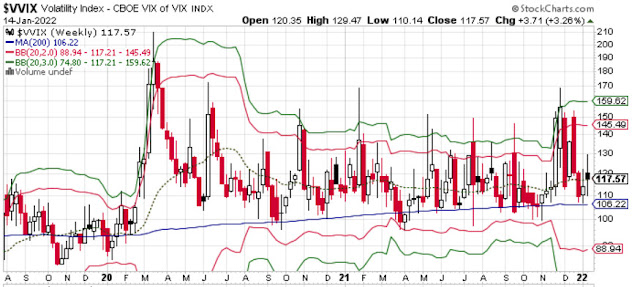- Volatility is related to several factors, and liquidity is only one of them
- In the context of volatility, it means that there are always plenty of buyers and sellers whenever someone wants to buy or sell.
- Liquidity keeps the bid-ask spread small. Liquidity by itself may not reduce the volatility of a stock, but a lack of liquidity can definitely cause wild volatility.
Volatility and the Amount of Consensus on Market Valuations
In [3], Steve Sosnick wrote that the amount of volatility is inversely proportional to the amount of consensus about market valuations.
If there were a perfect consensus on the valuation of a given item, then its price wouldn’t move. Conversely, if there were wildly divergent views about that item’s value, then its price would vary substantially. We certainly lack consensus about how to value the situation in Ukraine, and thus we have seen market volatility accompanying it.
Liquidity Can Affect Volatility
Multiple waves of uncertainty have swept over Wall Street in the past month (i.e., 2021 December): concerns about rising wages and inflation, the Omicron variant becoming widespread, and especially Federal Reserve turning more hawkish:[1]
Do not underestimate the effects of liquidity withdrawal. The mammoth balance sheet the Fed has built up was a key determinant of liquidity across markets. As balance sheet runoff is put into motion, the withdrawal of liquidity will have profound impacts. Determining how it plays out is far from straightforward and will be determined by a variety of factors. Understanding the details matters. So hold on tight – there’s volatility ahead.
These increasing waves of uncertainty drive rising implied volatility (VIX). The above chart shows the 200-week moving average of VVIX (Volatility of VIX) has slowly moved upward since the March 2020 correction[2]
Note how the Bollinger Bands for 2 and 3 standard deviations (red and green) have dramatically expanded in the last few weeks. We expect with all the uncertainty heading into 2022 that high volatility will be the new normal for markets.
Volatility Rise Also Triggers Futures Liquidity Crunch
Analysts have penned many posts about how the Federal Reserve tapering of bond purchases and possible interest rate hikes in 2022 will cause a liquidity crunch for investors.
Another faster-moving factor is adding to the liquidity crunch. That factor is liquidity falling in futures and derivatives markets when volatility rises. The following graph from Goldman Sachs shows how futures liquidity falls as the VIX rises:[2]
When liquidity falls, the decline in prices accelerates due to fewer buyers. Futures and options volumes are now greater than volumes in the underlying stocks. Thus, derivatives have an increasing influence on market prices and movement.
References
- Morgan Stanley: As The Fed's Balance Sheet Runoff Begins, The Withdrawal Of Liquidity Will Have Profound Impacts
- A Liquidity Crunch & Volatility Surge Is Coming In 2022
- Socially Acceptable Volatility Redux
- Liquidity Considerations Ahead of a Three-Day Weekend
- When Markets Are Wild, Embrace Liquidity
- Why is the VIX index related to the liquidity premium? (pdf)
- Liquidity, Volume, and Volatility (pdf)


No comments:
Post a Comment
Note: Only a member of this blog may post a comment.